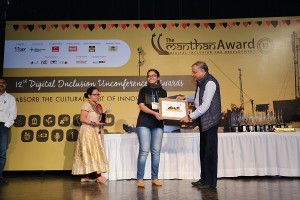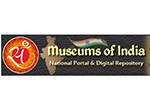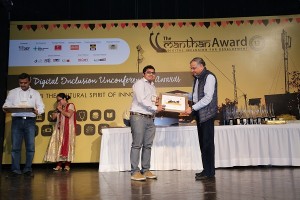e-Culture, Heritage & Tourism, Winner 2015
 Name of Project: Xondhan.com
Name of Project: Xondhan.com
Project Website: www.xondhan.com
Name of Organization: Xondhan
Organization Website: www.xondhan.com
Online e-magazine in Assamese language brings diaspora together
 Xondhan.com is an e-magazine in Assamese language that uses Unicode fonts. Very soon an Android app for this e-magazine will also be available in the market. Launched on July 15, 2012, the magazine publishes articles, poems, stories, interviews, recipes, travelogues, tourism-related articles, letters, cultural news, movie reports, career-related articles, etc. It is one of the oldest e-magazines published in the Assamese language. It is also the first Assamese e-magazine to introduce video interviews. The magazine has different sections among which poems, snapshots, sports, articles, tourism, interviews and sketches are getting more response from readers. The magazine collects articles, poems and other content typed in Unicode through email. It also has a provision for the non-Unicoded articles. For such articles it uses a converter to translate them into Unicode version. The basic aim of the magazine is to connect all Assamese people globally. The publishers want to give a chance to every individual who is interested in creative arts and Assamese culture, irrespective of his/her place of residence. Those who are in remote areas can read the same poem that can be read by those working in the USA, Canada, etc. at the same time. Thus, it also helps in connecting people globally through the internet. The online users of the magazine are primarily from the north eastern region of India, mainly from Assam state. However, the magazine also gets visitors from several other countries. During 2014 (January-December), Xondhan had 22,14,826 page hits and 1,51,542 page visits. During 2013 (January – December), it got approximately 4,13,167 page hits and 2,02,899 page visits. The magazine got visitors from more than 25 countries. In 2015, between January 1 and August 26, the magazine got 43,064 unique visitors and a total of 2,043,191.
Xondhan.com is an e-magazine in Assamese language that uses Unicode fonts. Very soon an Android app for this e-magazine will also be available in the market. Launched on July 15, 2012, the magazine publishes articles, poems, stories, interviews, recipes, travelogues, tourism-related articles, letters, cultural news, movie reports, career-related articles, etc. It is one of the oldest e-magazines published in the Assamese language. It is also the first Assamese e-magazine to introduce video interviews. The magazine has different sections among which poems, snapshots, sports, articles, tourism, interviews and sketches are getting more response from readers. The magazine collects articles, poems and other content typed in Unicode through email. It also has a provision for the non-Unicoded articles. For such articles it uses a converter to translate them into Unicode version. The basic aim of the magazine is to connect all Assamese people globally. The publishers want to give a chance to every individual who is interested in creative arts and Assamese culture, irrespective of his/her place of residence. Those who are in remote areas can read the same poem that can be read by those working in the USA, Canada, etc. at the same time. Thus, it also helps in connecting people globally through the internet. The online users of the magazine are primarily from the north eastern region of India, mainly from Assam state. However, the magazine also gets visitors from several other countries. During 2014 (January-December), Xondhan had 22,14,826 page hits and 1,51,542 page visits. During 2013 (January – December), it got approximately 4,13,167 page hits and 2,02,899 page visits. The magazine got visitors from more than 25 countries. In 2015, between January 1 and August 26, the magazine got 43,064 unique visitors and a total of 2,043,191.
 Name of Project: Go Heritage Runs
Name of Project: Go Heritage Runs
Project Website: www.goheritagerun.com
Name of Organization: GoUNESCO
Organization Website: www.gounesco.com
Promoting UNESCO heritage sites through online and offline initiatives
 GoUNESCO is a UNESCO New Delhi supported series of online and offline initiatives focused on making heritage fun. Through global projects such as online travel challenges, student programmes, heritage runs and social media campaigns GoUNESCO is providing avenues for thousands of people to engage with heritage in fresh and unique ways. The non-profit organisation has developed two websites www.gounesco.com and www.goheritagerun.com to create awareness of World Heritage Sites declared by UNESCO. The websites promote offline activities such as travel challenges for all people across the world, GoUNESCO Campus Ambassador programme for students and Go Heritage Runs centred around specific heritage sites that promote heritage as well as tourism and the healthy pursuit of running. Go Heritage Runs launched in 2014 are a series of fun runs held at
GoUNESCO is a UNESCO New Delhi supported series of online and offline initiatives focused on making heritage fun. Through global projects such as online travel challenges, student programmes, heritage runs and social media campaigns GoUNESCO is providing avenues for thousands of people to engage with heritage in fresh and unique ways. The non-profit organisation has developed two websites www.gounesco.com and www.goheritagerun.com to create awareness of World Heritage Sites declared by UNESCO. The websites promote offline activities such as travel challenges for all people across the world, GoUNESCO Campus Ambassador programme for students and Go Heritage Runs centred around specific heritage sites that promote heritage as well as tourism and the healthy pursuit of running. Go Heritage Runs launched in 2014 are a series of fun runs held at
heritage sites all across India. The run routes are always designed to ensure that participants traverse sites of historical significance; various aspects of arts, crafts, culture and heritage from the destination are weaved into the runner’s experience to provide a holistic experience to the runners; the runs are untimed, non-competitive events designed to enable families or groups of runners to explore heritage together and without the pressure of running against the clock; and run destinations are typically located close to large cities making them ideal for a weekend getaway. Go Heritage Runs is the commercial arm of GoUNESCO whose key objective is to create avenues for people to engage with heritage in fresh, fun ways and draw attention to underappreciated heritage sites. The runs also promote tourism as most runners are non-local and come from all over India. By bringing over 500 runners to a run destination and working with local artisans and businesses to design and execute finisher medals and other collaterals, each run has a significant impact on local tourism and economy
Special Mentions
 Name of Project: National Portal and Digital Repository for Museums of India
Name of Project: National Portal and Digital Repository for Museums of India
Project Website: www.museumsofindia.gov.in
Name of Organization: Centre for Development of Advanced Computing (C-DAC)
Organization Website: www.cdac.in
Online portal and digital repository showcases India’s museums
 The Centre for Development of Advanced Computing (C-DAC) has developed a national portal and digital repository for museums of India. The portal offers online and integrated access to digitised collections of 10 national Museums. The human-centred design and computing group at C-DAC Pune has designed and developed the portal as well as the software tools required for cataloguing and digital repository management. The project is funded by the Ministry of Culture, Government of India. The participating museums are National Museum in New Delhi; Allahabad Museum in Allahabad; Indian Museum in Kolkata; National Gallery of Modern Arts in New Delhi, Mumbai and Bengaluru; Archaeological Survey of India Museum in Goa and Nagarjunakonda; Salar Jung Museum in Hyderabad, and Victoria Memorial Hall in Kolkata. The main features of the national portal include introducing India’s rich heritage through a diverse range of digital collections in terms of sculptures, paintings, manuscripts, arms and weapons, terracotta, pottery, coins and a numerous other categories of antiquities; search and retrieval across all museums and categories; automatic keyword suggestions; parameter-based filtering of search results; high-resolution images with zoom-in/out and metadata; direct access to digital collections through categorisation; virtual exhibitions with scholarly essays published by museum curators; automatic timeline mapping of objects; dedicated homepages for museums managed by nodal officers; museum wise access to digital collections; museum wise event announcements; portal administration and scalable framework of virtual museums. At present, the national portal is providing online access to over 50,000 historical antiquities with approximately 2,00,000 digital images with metadata from 10 national museums. In the last 10 months, the portal has received 36,65,715 page hits which amounts to approximately 12,229 page hits daily.
The Centre for Development of Advanced Computing (C-DAC) has developed a national portal and digital repository for museums of India. The portal offers online and integrated access to digitised collections of 10 national Museums. The human-centred design and computing group at C-DAC Pune has designed and developed the portal as well as the software tools required for cataloguing and digital repository management. The project is funded by the Ministry of Culture, Government of India. The participating museums are National Museum in New Delhi; Allahabad Museum in Allahabad; Indian Museum in Kolkata; National Gallery of Modern Arts in New Delhi, Mumbai and Bengaluru; Archaeological Survey of India Museum in Goa and Nagarjunakonda; Salar Jung Museum in Hyderabad, and Victoria Memorial Hall in Kolkata. The main features of the national portal include introducing India’s rich heritage through a diverse range of digital collections in terms of sculptures, paintings, manuscripts, arms and weapons, terracotta, pottery, coins and a numerous other categories of antiquities; search and retrieval across all museums and categories; automatic keyword suggestions; parameter-based filtering of search results; high-resolution images with zoom-in/out and metadata; direct access to digital collections through categorisation; virtual exhibitions with scholarly essays published by museum curators; automatic timeline mapping of objects; dedicated homepages for museums managed by nodal officers; museum wise access to digital collections; museum wise event announcements; portal administration and scalable framework of virtual museums. At present, the national portal is providing online access to over 50,000 historical antiquities with approximately 2,00,000 digital images with metadata from 10 national museums. In the last 10 months, the portal has received 36,65,715 page hits which amounts to approximately 12,229 page hits daily.
 Name of Project: ConfirmTkt
Name of Project: ConfirmTkt
Project Website: www.confirmtkt.com
Name of Organization: Confirm Ticket Online Solutions Private Limited
Organization Website: www.confirmtkt.com
Predicting train ticket reservation confirmation chances
 ConfirmTkt is a ticket discovery tool which is changing the way people travel in India. It is trying to solve one of the biggest problems which Indian train travellers face every day: getting a confirmed ticket to travel. In India, almost 2.2 million tickets are booked on a daily basis of which about 7.9 lakh tickets are in the waitlist. This is a huge problem that an Indian train traveller faces. Many people just cancel their journey because they don’t get a confirmed ticket to travel. The ConfirmTkt algorithm predicts the train ticket confirmation chances based on the historical trends of the train and helps people assess the risks and plan their journeys better. The intelligence behind the ConfirmTKT wait list predictions is very close to how humans think. We humans predict and act on the future based on past experiences. In a similar way, ConfirmTKT algorithm analyses the past ticketing trends and predicts your ticket confirmation chances. ConfirmTKT maintains confirmation thresholds for every train and predicts the ticket confirmation chances based on them. ConfirmTkt is designed in such a way that it learns while it predicts. So, the more it predicts the more accurate and efficient it becomes. The algorithm also suggests alternative travel options if the ticket has low confirmation chances. Then it automatically fetches all the available alternative travel options on the same train. The algorithm discovers the alternative travel options by effectively utilising all the unused quotas on the same train: (i) either it suggests a break journey on the same train just by changing the seat/coach, or (ii) suggests booking a ticket up to the next available station from the destination. The benefit of these alternate travel options is that they are much cheaper than regular Tatkal tickets and one can be worry free.
ConfirmTkt is a ticket discovery tool which is changing the way people travel in India. It is trying to solve one of the biggest problems which Indian train travellers face every day: getting a confirmed ticket to travel. In India, almost 2.2 million tickets are booked on a daily basis of which about 7.9 lakh tickets are in the waitlist. This is a huge problem that an Indian train traveller faces. Many people just cancel their journey because they don’t get a confirmed ticket to travel. The ConfirmTkt algorithm predicts the train ticket confirmation chances based on the historical trends of the train and helps people assess the risks and plan their journeys better. The intelligence behind the ConfirmTKT wait list predictions is very close to how humans think. We humans predict and act on the future based on past experiences. In a similar way, ConfirmTKT algorithm analyses the past ticketing trends and predicts your ticket confirmation chances. ConfirmTKT maintains confirmation thresholds for every train and predicts the ticket confirmation chances based on them. ConfirmTkt is designed in such a way that it learns while it predicts. So, the more it predicts the more accurate and efficient it becomes. The algorithm also suggests alternative travel options if the ticket has low confirmation chances. Then it automatically fetches all the available alternative travel options on the same train. The algorithm discovers the alternative travel options by effectively utilising all the unused quotas on the same train: (i) either it suggests a break journey on the same train just by changing the seat/coach, or (ii) suggests booking a ticket up to the next available station from the destination. The benefit of these alternate travel options is that they are much cheaper than regular Tatkal tickets and one can be worry free.
